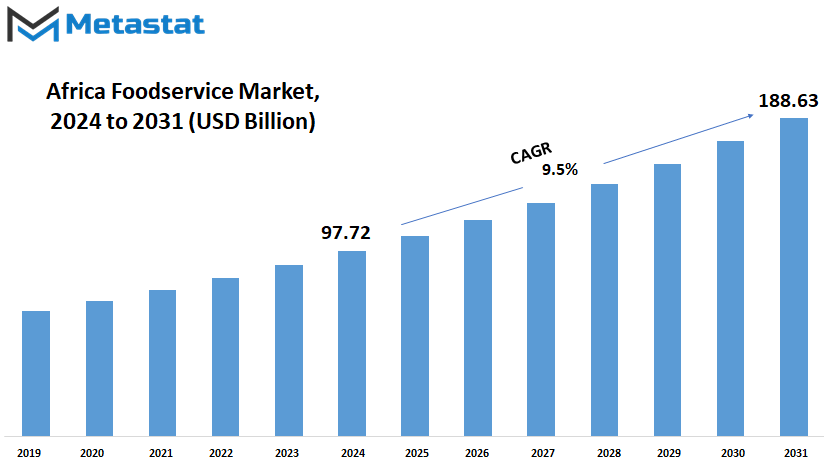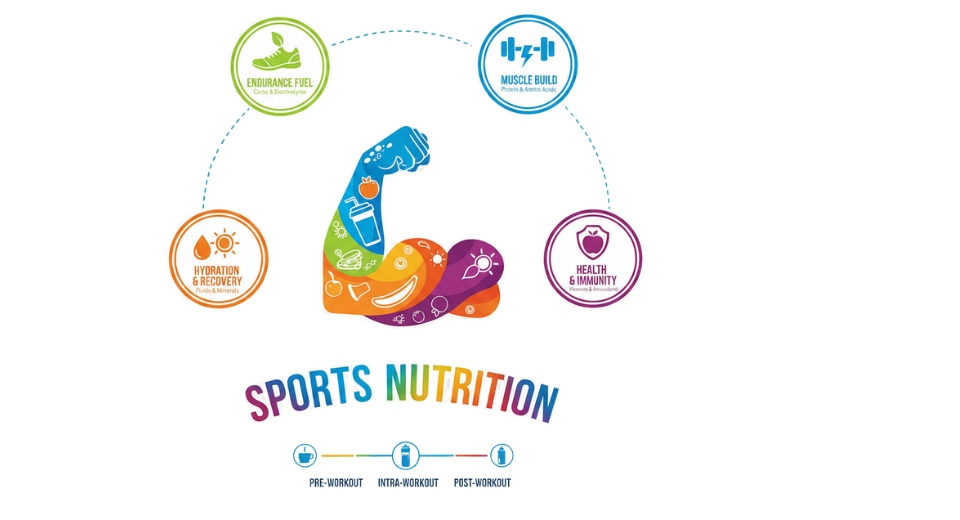MARKET OVERVIEW
The African Foodservice market is dynamic and multi-faceted commerce that forms a healthy portion of the economy and cultural presence on the continent. The foodservice industry includes restaurants, catering, cafes, and fast-food segments, reflecting the richly diversified culinary practices of the region and the modern taste of food. The frame of the African foodservice market has a mix of local traditions, international influences, and modern culinary trends that make the proposition applied in this region very wide-ranging.
The past years have seen the market go through quite a number of important changes, driven by urbanization, shifting consumer lifestyles, and technological innovation. With the trend of increasing migration of Africans to urban centers comes a corresponding increase in demand for quick, easy, and varied food. The market is evolving to cater to a fast-growing middle class with an increasing appetite for varied and quality food experiences. From fine dining restaurants in the cities to local pubs in rural areas, the market becomes very receptive to the evolving needs and tastes of its consumers.
One of the telling features of the Africa Foodservice market is its ability to adapt to situations and to 'bounce back.' Local entrepreneurs, just as established food service chains, thus continue to innovate in response to a varied customer base. This adaptability is reflected in the growth of meal delivery services and digital ordering platforms, which started to gain traction ever more strongly since the outbreak of the global pandemic. These technological developments can change a great deal how foodservice is conducted in Africa by opening it up to more accessibilities and conveniences for consumers.
Another defining aspect of the foodservice market in Africa is its cultural richness and diversity. Each of the regions in Africa has its culinary history: from the pungent stews of West Africa to the highly adorned tagines of North Africa. This forms one of the reasons for cultural diversity, which attracts the tourists, as well as making it integral to the foodservice needs of the tourism industry. It caters not only to the local population but also millions of tourists who come to Africa every year in search of authentic and memorable culinary experiences.
Sustainability and health consciousness—these are the emerging trends/avenues within the Africa Foodservice market. In terms of sustainable practices, there is increasing consumer awareness about their relevance. Similarly, increasing consumer awareness of the importance of healthy eating is another factor. This has led to higher demands for organically grown produce, plant-based meals, and eco-friendly packaging. In turn, food service providers have begun sourcing ingredients locally, reducing waste, and increasing more nutritious menu options. The trend stays keen on continuing to change the market in the future.
The market will continue growing, driven by global trends and local innovation. Infrastructure, technology, and human resource investments are very key and will determine the course of its development. As the economy grows and urbanizes, so does the demand for varied, good-quality food service options, further propelling the growth and transformation of the industry.
The foodservice market in Africa is vibrant and part and parcel of the continental economy and cultural landscape. Driven by increasing urbanization, technological advancement, cultural diversity, and new trends in sustainability and health consciousness, the evolution is happening with this market. How well it adapts and innovates will spell its future success. African foodservice, rich in culinary heritage, offers unparalleled opportunity for future growth and development.
Africa Foodservice market is estimated to reach $188.63 billion by 2031; growing at a CAGR of 9.9% from 2024 to 2031.

GROWTH FACTORS
The Africa foodservice market is growing rapidly and has huge growth prospects in the near future. Several reasons support this optimistic outlook. First and foremost, the rise of urbanization underway across the continent: as more and more people move into the cities, there is growing demand for convenient, varied food options—something foodservice providers are keen to cater to. Again, with most African nations seeing the rise of the middle class, this growth comes with disposable incomes that enable populations to dine out and be adventurous with food. This shift in behavior is creating a robust market for local and international foodservice companies.
The other important role played in the shaping of the Africa foodservice market is technological advancement. Growing usage of smartphones and access to improved internet facilitate the growth of food delivery services and online ordering platforms. This convenience will attract a younger, more tech-savvy population that would rather prefer ordering food online than cooking at home. In addition, the digital payment systems adopted will make the transactions smoother and secure, hence encouraging more people to use such services.
However, several factors may hinder the growth of this market. First, there are infrastructural issues related to unreliable electricity and poor road networks, which make it very difficult for food service providers, especially in rural areas. There are also regulatory challenges and bureaucratic red tape that delay business operations and expansions. Despite these, firms are trying to find new ways around these constraints, such as solar-powered equipment and local delivery services that can hurdle difficult terrains.
Probably one of the most exciting opportunities for the foodservice market in Africa is its growing interest in health and wellness. The demand for healthy and organic food increases when people become concerned about health. Foodservice providers will likely win if they align with this trend through healthy menu items and transparency in sourcing practices. Moreover, emphasis is being put on sustainable and eco-friendly practices. More customers would prefer a business moving towards eco-friendly operations.
The African foodservice market holds extreme potential for steady growth, characterized by urbanization, rising income, and technological takeoff. Opportunities for expansion and innovation are high, though many are the challenges to be surmounted. Businesses that will be able to address these challenges by leveraging off emerging trends are going to benefit greatly in the next years. Provided that the right strategies and application of consumer preference drivers are deployed, then the future prospect for the foodservice market appears bright in Africa.
MARKET SEGMENT
By Type
The African foodservice market is diverse and possesses significant potential for growth in the next few years. The segmentation in this particular market will be done, including full-service restaurants, quick-service restaurants, cafés and bars, and other eating places. In all dimensions, each segment has its own opportunities and challenges that will define the future of the foodservice industry on the continent.
In Africa, full-service restaurants serve an array of dishes and a higher level of customer service than other kinds of restaurants. Increasing urbanization will push up the demand for such restaurants. Consumers are always looking for a place to eat that offers quality food with excellent service. It is perceived that this trend will fuel the growth of full-service restaurants in large cities where the middle class is on the rise. The ambiancy atmosphere, together with the various items on menus, will be of interest not only to locals but also to tourists.
Another vital segment in the Africa foodservice market is quick-service restaurants commonly known as fast food restaurants. Quick-service restaurants have gained popularity because they offer convenience, lower prices, and quickened service. Quick-service restaurants are propelling demand due to increased busy urban lifestyles and a rising number of younger consumers who are more likely to consume quicker and easier fast-food options. Advanced technologies, such as mobile ordering and delivery applications, would be more likely to improve this segment. This will provide the customers with the facility even more easily through which they can have their favorite meals without any wait.
Cafés and bars play important roles in the social and culinary scene in Africa. In fact, these are the very institutions where customers do not just go in to drink coffee or cocktails but also to socialize and relax. This growth in café culture is especially felt in the younger populations, who are after trendy spots where friends can meet over a drink or two with a snack or two. As incomes grow, more and more people will be in a position to afford spending on leisure activities, thus seeing the growth of cafés and bars across the continent.
The dining market in Africa is also host to other formats, including street food vendors and pop-up restaurants, all of which make for a dynamic market in food service. Street food, in particular, offers authentic culinary experiences at relatively low prices, deeply rooted in local cultures. This targets a broad consumer base, from daily commuters to tourists looking to indulge in local flavors. Such flexibility and reduced operational costs bring them as part and parcel of foodservice.

By Outlet
The Africa foodservice market is one of the dynamic and fast-growing industries that hold great potential in the future. This is driven by the increased demand for various food types and eating-out convenience-oriented options, hence shaping the food service landscape as a vibrant and highly competitive market characterized by a wide range of outlets to cater to different tastes and preferences of consumers.
The major segmentation in the foodservice market within Africa may be between chained outlets and independent outlets. Chained outlets are mostly big national or international brands. They offer consistency, reliability, and familiarity to customers. Chains are broadening their presence across the continent due to the growing middle class and rising appetite for standardized dining experiences of good quality. The ability of the chains to maintain uniform standards and provide a known product gives them a competitive edge, especially in urban areas where consumers seek convenience and trust established brands.
On the other hand, independent outlets bring variety to the market. These could be family-run restaurants or even foodservice ventures with a new approach, providing variety and impetus into the foodservice sector.
By Location
The Africa Foodservice market is bound to grow impressively in the next few years. Of the many factors, the major ones driving growth are urbanization, changing consumer preference, and economic development. Another development observed is the growing demand for a variety of dining out options. This would result in several distinct segments in the market, based on locations, such as retail, entertainment, freestanding, travel, and others.
The retail outlets—malls and supermarkets—start playing a pivotal role in the market. Many consumers of today look for convenience, and these outlets provide a range of dining choices with convenience in shopping. Getting a quick bite or snack with shopping convenience has become very attractive to the busy urbanite. Food courts in malls are also becoming increasingly important and a definite favorite attraction that draws in a crowd of people who look for variety in their dining options.
Furthermore, entertainment places, such as cinemas, amusement parks, and sports arenas, are also contributing to the foodservice industry. All these joints accommodate huge crowds that need snack or full-meal food service facilities. The food service provided in these outlets is incorporated as part of the whole entertainment; thus, people would want to experience the best while attending such events. With an augmented entertainment industry, there will be an augmented need for quality food service outlets.
These free-standing restaurants from fast foods to fine dining run independently of larger complexes and abound in Africa. Chains in fast food, fine dining, and everything in between cater to all tastes and cuisines of the population. A new breed of local entrepreneurs and international brands has set the scene alight, offering consumers choice. Freestanding restaurants also allow for more personalized and unique dining experiences, which can be a significant draw for customers.
Another key sector in the food service market of Africa includes the travel sector, like airports, railway stations, and bus stations. With increased traveling across the continent and more people on the move, there is now a growing demand for quick quality food along such places. Most travelers seek quick meals which would also fill them up, and food service providers who answer this call would see immense growth.
Other establishments, such as schools, hospitals, and corporate houses, also contribute to the foodservice market in Africa. Each of these places requires foodservice establishments that are capable of providing reliable and varied food to their students, patients, or employees. Growing awareness regarding health and balanced diet is expected to influence the foodservice in these institutes.
The African foodservice market is rapidly growing, where every location-based segmentation contributes to its growth. With increasing urbanization and changing consumer preferences, demand for diversified and quality foodservice would increase. It allows providers to adapt to the changing need of every segment and thereby continue to be competitive in this ever-changing and fast-moving market.
By Region
On the back of dynamic changes across the continent, the Africa Foodservice market spells huge growth opportunity. Therefore, regional segmentation implicates every region in the continent presents a different scenario in terms of opportunity and challenge. For instance, Nigeria represents a robust demand with its huge youthful population. This demand is influenced by the urbanization and rising middle class that desires both traditional and international cuisines. This pace is matched by that of the economic development and hence urbanization. The growth of food service industries in the country intertwines the deepest culinary tradition with modern food service, hence providing a rich breeding ground for expansion in the market.
Egypt’s foodservice market is also fueled by a lively tourism industry. It is a beehive of the country’s many perennial visitors who are interested in learning about different culinary habits. Another common feature in Egypt for all restaurants and food outlets is that they are both locally and internationally attuned, making the market so vibrant. Morocco is known for its excellent culinary heritage, and it is no exception where foodservice market activity is under concern. Blending traditional Moroccan cuisine with a modern twist result in great variety and opportunity for dining for locals and tourists.
Boosting the foodservice industry within the country is growing urbanization and economic development. New opportunities for foodservice players are taking shape with the growth in modern shopping malls in the country and the influence of global trends in food. Consequently, Algeria witnesses an upsurge in the foodservice sector, whereby the rich culinary culture that this country boasts is considered. Overwhelming preference for local flavours marks the market, though international aesthetics are gradually making an entrance.
South Africa is the most well developed among all the countries in Africa in terms of infrastructure, and the culinary scape is highly diverse. The demographic mix creates a mix in regards to the culture’s influences on the cuisine; hence, the foodservice market happens to be vibrant and diverse. South Africa’s foodservice market is light-years ahead of its other African contemporaries, and therefore it does provide a template for the other countries to scale up and modernize their markets.
Across the Rest of Africa, the foodservice market reflects much diversity, mirroring what the continent is in cultural and economic terms. In fact, different stages of market development are at play in the countries belonging to this group. However, what remains similar is rising urbanization and increasing disposable incomes that drive demand for diversified and convenient dining options.
Going forward, the outlook for the foodservice market in Africa remains optimistic. Such technological innovations, especially when combined with new business models, will most probably define the future of this market. Mobile technologies and online platforms are already changing the ways in which consumers interact with foodservice providers, thereby enabling businesses to reach out to a larger cross-section of customers. The Africa Foodservice market continues to evolve into an evergreen space with dynamic opportunities in response to growth and development of the continent.
COMPETITIVE PLAYERS
The food-service market in Africa is increasingly growing fast due to a variety of factors. Some of the major companies within this sector are Famous Brands Limited, Laudian Franchise Management One Pty Ltd, McDonald's Corporation, Restaurant Brands International Inc, Roman's Pizza, Spur Corporation Limited, Vida e Caffè Holdings, Yum! Brands Inc, Nando's Group Holdings, and Bidvest Foodservice. Accordingly, these firms actively drive the market landscape through diversified dining experience provision and expansion over the surface of the continent.
Famous Brands Limited is famous for its brand portfolio of consumer-favorite QSR and casual-dining brands. Growth has been achieved through new concepts and via diversifying into cater to diversified consumer preferences and needs. Laudian Franchise Management One Pty Ltd launches franchise-managing expertise in the partner-front following the brand's expansion. McDonald's Corporationcontinues to be an active competitor, expanding its footprint in more African countries with its internationally-popular menu and operations model that delivers quick and efficient service.
In the same direction, the operational commencement of the Africa Foodservice market is also being initiated by the parent Company of Burger King, Restaurant Brands International Inc. Quality coupled with affordance lures a large group of consumers. The pizzeria chain flagship at home, Roman's Pizza, now extends its portfolio by introducing a spectrum of pizza offerings custom made for local palates. Spur Corporation Limited is yet another sectoral significant that is contributing to the market's rapid growth coupled with its consumer-oriented family dining experience.
Vida e Caffè Holdings Pty Ltd is capitalizing on this new coffee culture sweeping across the continent by introducing an innovative range of drinks and light meals that provide appeal to urban consumers. Yum! Brands Inc, with its KFC, Pizza Hut, and Taco Bell brands, is aggressively expanding, drawing on its experiences worldwide in capturing African consumers. The Nando's Group Holdings, renowned for its flame-grilled Peri-Peri chicken, pushes the penetration even higher with power in flavor and experience.
One of the companies leading in the support of the Africa Foodservice market is Bidvest Foodservice (Bidfood), which has a wide-ranging supply of food products and associated services in the area of restaurants and catering establishments. With their broad distribution network, they make sure that foodservice operators are supplied with quality ingredients and reliable supplies.
The future of the market is promising. It will push the demand for different convenience dining options, given the continued investment among these keystones, rising middle class, and urbanization. These growth prospects of the market have been further boosted by technological advancements, among which include online ordering and delivery services. This market will continue to expand in terms of growth through the development of the new concept that is adopted by those firms managing the market.
Africa Foodservice Market Key Segments:
By Type
- Full Service Restaurants
- Quick Service Restaurants
- Cafés and Bars
- Others
By Outlet
- Chained Outlets
- Independent Outlets
By Location
- Retail
- Entertainment
- Freestanding
- Travel
- Others
By Region
- Nigeria
- Ethiopia
- Egypt
- Morocco
- Kenya
- Algeria
- South Africa
- Rest of Africa
Key Africa Foodservice Industry Players
- Famous Brands Limited
- Laudian Franchise Management One Pty Ltd
- McDonald's Corporation
- Restaurant Brands International Inc
- Roman's Pizza
- Spur Corporation Limited
- Vida e Caffè Holdings (Pty) Ltd
- Yum! Brands Inc
- Nando's Group Holdings
- Bidvest Foodservice (Bidfood)
WHAT REPORT PROVIDES
- Full in-depth analysis of the parent Industry
- Important changes in market and its dynamics
- Segmentation details of the market
- Former, on-going, and projected market analysis in terms of volume and value
- Assessment of niche industry developments
- Market share analysis
- Key strategies of major players
- Emerging segments and regional growth potential








 US: +1 3023308252
US: +1 3023308252






